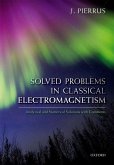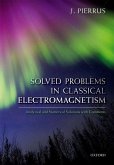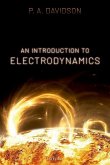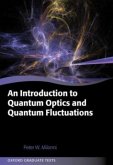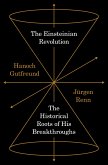Prof Richard Freeman (Ohio State University), Dr James King (National Security Technologies), Dr Gregory Lafyatis (Ohio State University)
Electromagnetic Radiation
Prof Richard Freeman (Ohio State University), Dr James King (National Security Technologies), Dr Gregory Lafyatis (Ohio State University)
Electromagnetic Radiation
- Broschiertes Buch
- Merkliste
- Auf die Merkliste
- Bewerten Bewerten
- Teilen
- Produkt teilen
- Produkterinnerung
- Produkterinnerung
This graduate level textbook aims to teach fundamental ideas of advanced classical electrodynamics, with an emphasis on the physics of radiation. The text describes concepts with the minimum required mathematical detail, while the accompanying side notes and end of chapter discussions provide the detailed derivations.
Andere Kunden interessierten sich auch für
![Solved Problems in Classical Electromagnetism Solved Problems in Classical Electromagnetism]() J. Pierrus (Senior Lecturer, Senior Lecturer, School of Chemistry aSolved Problems in Classical Electromagnetism114,99 €
J. Pierrus (Senior Lecturer, Senior Lecturer, School of Chemistry aSolved Problems in Classical Electromagnetism114,99 €![Solved Problems in Classical Electromagnetism Solved Problems in Classical Electromagnetism]() J. Pierrus (Senior Lecturer, Senior Lecturer, School of Chemistry aSolved Problems in Classical Electromagnetism57,99 €
J. Pierrus (Senior Lecturer, Senior Lecturer, School of Chemistry aSolved Problems in Classical Electromagnetism57,99 €![An Introduction to Electrodynamics An Introduction to Electrodynamics]() P. A. Davidson (Professor of fluid me Professor of fluid mechanicsAn Introduction to Electrodynamics77,99 €
P. A. Davidson (Professor of fluid me Professor of fluid mechanicsAn Introduction to Electrodynamics77,99 €![An Introduction to Quantum Optics and Quantum Fluctuations An Introduction to Quantum Optics and Quantum Fluctuations]() Prof Peter Milonni (Laboratory Fellow and Labor Research ProfessorAn Introduction to Quantum Optics and Quantum Fluctuations53,99 €
Prof Peter Milonni (Laboratory Fellow and Labor Research ProfessorAn Introduction to Quantum Optics and Quantum Fluctuations53,99 €![Introduction to Quantum Optics and Quantum Fluctuations Introduction to Quantum Optics and Quantum Fluctuations]() Peter W. Milonni (Laboratory Fellow and Loas Al Research ProfessorIntroduction to Quantum Optics and Quantum Fluctuations137,99 €
Peter W. Milonni (Laboratory Fellow and Loas Al Research ProfessorIntroduction to Quantum Optics and Quantum Fluctuations137,99 €![The Einsteinian Revolution The Einsteinian Revolution]() Hanoch GutfreundThe Einsteinian Revolution27,99 €
Hanoch GutfreundThe Einsteinian Revolution27,99 €![An Introduction to Special Relativity for Radiation and Plasma Physics An Introduction to Special Relativity for Radiation and Plasma Physics]() Greg Tallents (University of York)An Introduction to Special Relativity for Radiation and Plasma Physics68,99 €
Greg Tallents (University of York)An Introduction to Special Relativity for Radiation and Plasma Physics68,99 €-
-
-
This graduate level textbook aims to teach fundamental ideas of advanced classical electrodynamics, with an emphasis on the physics of radiation. The text describes concepts with the minimum required mathematical detail, while the accompanying side notes and end of chapter discussions provide the detailed derivations.
Hinweis: Dieser Artikel kann nur an eine deutsche Lieferadresse ausgeliefert werden.
Hinweis: Dieser Artikel kann nur an eine deutsche Lieferadresse ausgeliefert werden.
Produktdetails
- Produktdetails
- Verlag: Oxford University Press
- Seitenzahl: 640
- Erscheinungstermin: 28. Mai 2024
- Englisch
- Abmessung: 246mm x 172mm x 32mm
- Gewicht: 1226g
- ISBN-13: 9780198899686
- ISBN-10: 0198899688
- Artikelnr.: 69719802
- Herstellerkennzeichnung
- Libri GmbH
- Europaallee 1
- 36244 Bad Hersfeld
- gpsr@libri.de
- Verlag: Oxford University Press
- Seitenzahl: 640
- Erscheinungstermin: 28. Mai 2024
- Englisch
- Abmessung: 246mm x 172mm x 32mm
- Gewicht: 1226g
- ISBN-13: 9780198899686
- ISBN-10: 0198899688
- Artikelnr.: 69719802
- Herstellerkennzeichnung
- Libri GmbH
- Europaallee 1
- 36244 Bad Hersfeld
- gpsr@libri.de
Richard Freeman received his undergraduate degree in physics from the University of Washington and his Ph.D. from Harvard studying molecular interactions under Norman Ramsey in 1973. He did post-doctoral work at MIT investigating Rydberg atoms under Daniel Kleppner. He spent 20 years at Bell Laboratories developing experimental tools to understand the effects of intense light on atoms and molecules. In 1996, he moved to the University of California where he continued his interests in intense light interactions with matter. In 2003, he was appointed Dean of Mathematical and Physical Sciences at The Ohio State University where he continued his studies of matter under extreme conditions. James A. King received a Bachelor's degree in Physics and a PhD in Applied Science from University of Nevada, Las Vegas and University of California, Davis, respectively. He worked at LLNL as a graduate student and at UCSD and OSU and a postdoctoral researcher. Presently he is employed by NSTec. Gregory Lafyatis received his undergraduate degree in electrical engineering from MIT and Ph. D in physics from Harvard where he experimentally studied atomic and molecular processes of astrophysical interest. His post-doctoral work included helping to develop a single ion trap for use in ultra-high precision mass spectroscopy and early work in trapping laser cooled neutral atoms. In his faculty position at Ohio State University, he has made contributions in a variety of atomic, molecular, and optical physics including cold atom experiments, condensed matter motivated atomic beam experiments, biologically motivated optical tweezer experiments, and single photon detectors for quantum information applications.
Part I: Introductory Foundations
1: Essentials of Electricity and Magnetism
2: The Potentials
Part II: Origins of Radiation Fields
3: General Relations between Fields and Sources
4: Fields in terms of the Multiple Moments of the Source
Part III: Electromagnetism and Special Relativity
5: Introduction to Special Relativity
6: Radiation from Charges Moving at Relativistic Velocities
7: Relativistic Electrodynamics
8: Field Reactions to Moving Charges
Part IV: Radiation in Materials
9: Properties of Electromagnetic Radiation in Materials
10: Models of Electromagnetic Response of Materials
11: Scattering of Electromagnetic Radiation in Materials
12: Diffraction and the Propagation of Light
13: Radiation Fields in Constrained Environments
1: Essentials of Electricity and Magnetism
2: The Potentials
Part II: Origins of Radiation Fields
3: General Relations between Fields and Sources
4: Fields in terms of the Multiple Moments of the Source
Part III: Electromagnetism and Special Relativity
5: Introduction to Special Relativity
6: Radiation from Charges Moving at Relativistic Velocities
7: Relativistic Electrodynamics
8: Field Reactions to Moving Charges
Part IV: Radiation in Materials
9: Properties of Electromagnetic Radiation in Materials
10: Models of Electromagnetic Response of Materials
11: Scattering of Electromagnetic Radiation in Materials
12: Diffraction and the Propagation of Light
13: Radiation Fields in Constrained Environments
Part I: Introductory Foundations
1: Essentials of Electricity and Magnetism
2: The Potentials
Part II: Origins of Radiation Fields
3: General Relations between Fields and Sources
4: Fields in terms of the Multiple Moments of the Source
Part III: Electromagnetism and Special Relativity
5: Introduction to Special Relativity
6: Radiation from Charges Moving at Relativistic Velocities
7: Relativistic Electrodynamics
8: Field Reactions to Moving Charges
Part IV: Radiation in Materials
9: Properties of Electromagnetic Radiation in Materials
10: Models of Electromagnetic Response of Materials
11: Scattering of Electromagnetic Radiation in Materials
12: Diffraction and the Propagation of Light
13: Radiation Fields in Constrained Environments
1: Essentials of Electricity and Magnetism
2: The Potentials
Part II: Origins of Radiation Fields
3: General Relations between Fields and Sources
4: Fields in terms of the Multiple Moments of the Source
Part III: Electromagnetism and Special Relativity
5: Introduction to Special Relativity
6: Radiation from Charges Moving at Relativistic Velocities
7: Relativistic Electrodynamics
8: Field Reactions to Moving Charges
Part IV: Radiation in Materials
9: Properties of Electromagnetic Radiation in Materials
10: Models of Electromagnetic Response of Materials
11: Scattering of Electromagnetic Radiation in Materials
12: Diffraction and the Propagation of Light
13: Radiation Fields in Constrained Environments


